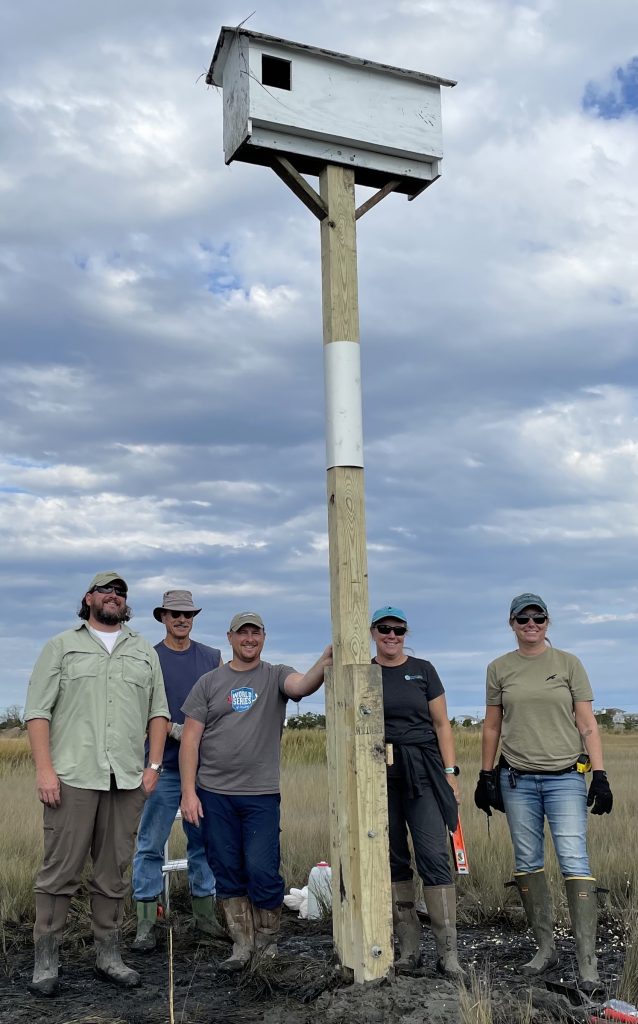Insight into a Nocturnal and Enigmatic New Jersey Raptor
by Melanie Mason, Assistant Biologist

Barn Owls (Tyto alba) are one of the most widespread avian species in the world. Despite this impressive distribution, their numbers have been decreasing in parts of their range, and New Jersey is no exception. The extent of their decline isn’t fully known since barn owls are nocturnal and enigmatic, so it’s difficult to estimate their numbers. Although barn owls can travel great distances to disperse after fledging and to find prey, they don’t truly migrate. Therefore, there isn’t a breadth of migration data to sift through in order to triage their downward trend either.
The first step in species conservation is to understand its biology. Because barn owls aren’t migratory, they don’t have the intense energy requirements needed to fuel long distance treks to warmer climates, but the trade-off is they are at the mercy of their local prey abundance and availability. If you look at a distribution map of North American barn owls, you’ll see that New Jersey is close to the northernmost extent of their range. In fact, the majority of their subspecies/races are found in lower latitudes. Unlike their tropical kin, however, northern owls have to frequently survive freezing conditions and in order to do so, need food and lots of it!
Catching enough prey through New Jersey winters can be a challenge in and of itself, but if owls lack sufficient fat stores because of an unfavorable prey year (think hurricanes, floods, droughts, etc), they can easily succumb to cold conditions and die from exposure. The reality is that many young owls do not survive their first winter — a very steep learning curve.
Their preferred prey is meadow vole which are close relatives of lemmings — made famous for their explosive populations during favorable years. In order to respond to sweeping changes in prey availability, the reproductive strategy of barn owls is atypical for most raptors. Where small clutches and high parental investment are the norm, instead, barn owls are capable of breeding year round in favorable conditions (generally fall/spring here in New Jersey) and can have large clutches in order to respond quickly to prey availability. Another uncommon and well-documented strategy is polygyny — where one male sires and provides for multiple nests.
These reproductive strategies are important since barn owls are not a long lived species and typically do not survive much longer than five years. Their saving grace is their ability to “bounce back” and quickly repopulate local areas. This is where we can help!
Barn owls get their name from their close association with humans. They hunt in marshes, fields and grasslands typically favored for agriculture. They frequently nest in structures like old barns, buildings and silos. Constructed structures such as barns and nest boxes are generally preferred over natural cavities (dead or hollow trees for example) because they are safer from predators, more protected from the elements and have a vast supply of mice and voles at their doorstep. As silos and old barns fall down or are torn down in favor of newer, longer lasting metal structures, these nest boxes are even more critical to provide nesting opportunities.
The goal of our barn owl project is to provide safe nesting structures for barn owls in suitable habitat throughout the state. We also hope to gain insight into owl occupancy and nesting success in previously un-monitored areas of New Jersey.
Four ways to help barn owls:
- Report any sightings, any time of year. While we are most interested in bolstering the breeding population, identifying winter habitat is critical as well.
- Barn owls are better for the environment than barn cats since they are native and don’t kill songbirds, so consider housing barn owl instead! They’ll alleviate your rodent problem without the cost of feeding and risk of unwanted litters.
- Don’t use rodenticides! They can harm or kill barn owls (and many other species too), plus owls often do a better job than poisons and are safer for everyone.
- Know a potential location or just want to learn more? Email me at melanie.mason@conservewildlifenj.org. I want to hear from you!
The generous support of Washington Crossing Audubon Society provided quite literally the nuts and bolts of the fledgling nest box project by facilitating purchase of supplies for nest box construction — a million times thank you!
Learn More:
Melanie Mason is the Assistant Biologist for Conserve Wildlife Foundation of New Jersey.


